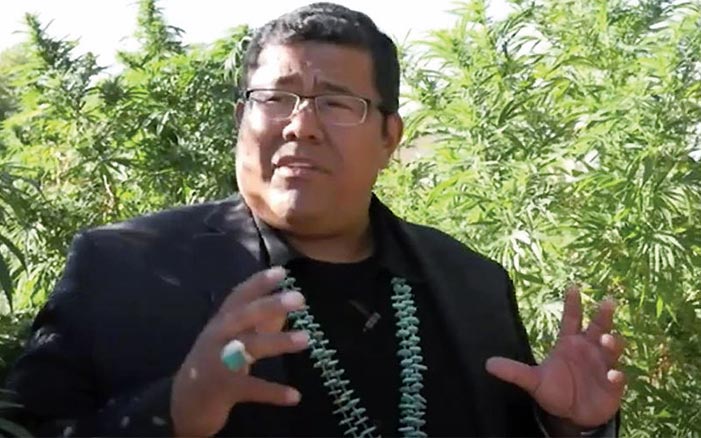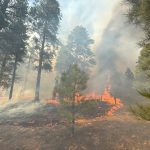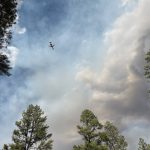
2020 in Review: Cannabis farmer still free after major bust
WINDOW ROCK
When the Federal Bureau of Investigation got to Dineh Benally’s hemp (or what has been actually found to be marijuana) farms they reported it to be one of the largest ever illegal cannabis operations in the country.
Right under the Navajo Nation’s nose, Benally was able to get 36 farms, spanning well over 400 acres, with hundreds of thousands of live marijuana plants worth an estimated billions of dollars.

Courtesy photo
In this photo from Dineh Benally’s company website, Benally stands in front of a field of cannabis.
The plants were cultivated in the Northern Agency of the Navajo Nation, starting in Shiprock and then spanning outward to other communities like Gadii’ahi and Hogback.
How did the Navajo Nation leadership not stop this? Some will say COVID-19 had taken the attention of leadership, but in reality the hemp farms were known to be in the development process a year before the global pandemic arrived.
After speaking with the Navajo Nation Police a year prior, I was told they had taken samples of the plants to get tested, but the results came back inconclusive months later.
I was assured leadership knew about it, but no one addressed it. I eventually forgot about the farms, thinking there would be a stop to them before they gained any momentum.
I was wrong. It took an exasperated resident taking it upon herself to give me and photojournalist Sharon Chischilly a tour of some of the farms and hoop houses that were being built. The resident also took me to speak to a family and their neighbor who were being harshly impacted by the hemp farms that surrounded their homes.
This was in June and everything was ramping up. These neighbors of Benally had at the time no support from the chapter or their Council delegate, and they were desperate.
Due to the lack of quick response from leadership at the first sign of the hemp/marijuana farms, the farms grew in size and became a horrible nuisance to residents who were not entangled with the Benally hemp/marijuana business themselves. It became the great divider in the community, causing enemy among family and neighbors. It brought fear into the community due to undocumented non-Navajo farm workers.
The mastermind behind the farms, Benally, exploited the low socio-economic make up of the Navajo Nation and used it for his benefit. Causing more than disharmony among the people in the community, the farms also brought damage to the land that has yet to be addressed.
In order for this massive marijuana operation to be stopped it took Shiprock and other neighboring community voices, and the Navajo Nation Police, to sound the alarm. Since leadership wasn’t responding and residents continued to report the activity, Navajo Nation Police decided to send a press release out to reassure the community they are aware of the farms and a task force was in place.
This press release lit a fire under leadership, and a few days later the Navajo Department of Justice sent out its own press release announcing it had requested a preliminary injunction and temporary restraining order against Benally, his Native American Agriculture Company and Navajo Gold Company to stop operations.
But operations continued for nearly five months. Of course, other departments such as the Navajo Environmental Protection Agency and the prosecutor’s office, along with NDOJ’s special counsel, had a lot to do with the ultimate shutdown of the farms, but at the beginning the community and police tried to find a way to get leadership to react. There were hiccups throughout this whole ordeal between police and residents.
I’m not saying it was always a cohesive relationship. But ultimately they were able to make enough noise to elicit a reaction. Even after farms stopped operating, communities were left with unaddressed issues, and Benally continues to be free. This is in large part due to the Navajo Nation courts.
The summer of 2020 was a contentious summer between citizens and police across the country, and rightfully so. Citizens fed up with Black men and women being murdered by police officers took to the streets in unison demanding change, such as defunding of the police. To combat these protesters, militarized police across the country wore riot gear and carried powerful guns and weapons. The funding for this type of police gear was seen as more than frivolous, when it was only recently that nurses and doctors were using garbage bags as their PPE’s while on the front lines of treating COVID-19 patients.
But on the Navajo Nation there was a different type of protest going on. It was Shiprock residents who were sick of the hemp farms in their community taking to the streets. During these protests, officers were accommodating, but the frustration against Dineh Benally, his hemp farms, farm workers, lack of community leadership, and the court system made protesters turn their frustration toward police for what they saw as insufficient response to the hemp issue as well as not arresting Benally.
But throughout the months of the issue, police officers were available to talk with residents during community meetings, which some attendees live-streamed on social media. There had been maybe a community meeting here and there where other leadership would show up and face the farmers. Leadership more or less took a back seat.
There had been a couple of radio forums, a couple of committee meetings and an amendment to Title 17, but these forums and committee meetings usually were answering questions that had already been answered, or rehashing the events, or basically reiterating what I had already covered the entire summer.
When asked about the situation at the beginning of the summer the Shiprock delegate sent me an email stating, “Hemp is not illegal on the Navajo Nation” and that “Hemp production is happening up and down the San Juan River, not just in Shiprock,” and then advised me to look at the Navajo Nation Code book.
As leadership continued with this dog and pony show of radio forums, residents became louder and more active. Navajo Nation Police Chief Phillip Francisco testified during a September hearing that the whole hemp/marijuana farm was a “crisis situation” and was taking manpower away from other districts in order to deal with the problem. Francisco gave his testimoney in the old Shiprock post office, where his staff was working out of, because the Shiprock Police Department is an old building considered a health hazard. This proving again the neglect the Navajo police force has endured from Navajo leadership, especially during a pandemic where police has been working nonstop.
This hearing was three months after the lawsuit was filed, and after the hearing the preliminary injunction and TRO were granted.
It also took testimony from then-NEPA director Oliver Whaley to shed light on the devastation the land has endured due to the hemp/marijuana farms. He and his team had inspected the farms found damage to land and water. Since this September hearing, the Nation has attempted to have an order-to-show-cause hearing, which could have been used as justification to incarcerate Benally because he continued to operate even after the restraining order was granted.
But the Shiprock court and its judge delayed the hearing and have yet to reschedule another hearing, allowing Benally to stay free from any jail time or paying any fines. The community continued to express their frustration at the slow process of halting the farms.
As they expressed this to officers, as well as their belief that even officers were paid off by Benally, Francisco maintained that there was a legal process in place and had to be followed correctly or it would give Benally the ammo he needed to win in the courts. But what Francisco did not tell the community was that he and his team was meeting with FBI and other neighboring police departments, which he himself worked for prior to becoming Navajo Nation police chief in 2016.
This nearly two months of plotting and planning led to Operation Navajo Gold where Navajo Nation Police, FBI and other authorities executed search warrants at these farms, some of which were determined to be marijuana operations. After Operation Navajo Gold, there was a disappointing lack of Navajo leadership acknowledgment, except from the Navajo Nation president, for the diligent work of the Navajo Nation Police.
There was also no mention made to the communities that had to endure this ordeal for months, and no acknowledgment of the community’s part in bringing down one of the largest hemp/marijuana farms eradicated in the country.
The issues that result from these farms persist and Benally for the most part hasn’t paid for the cleanup of the damaged land, or for anything. He still walks freely.








 Highway 264,
Highway 264, I-40, WB @ Winslow
I-40, WB @ Winslow